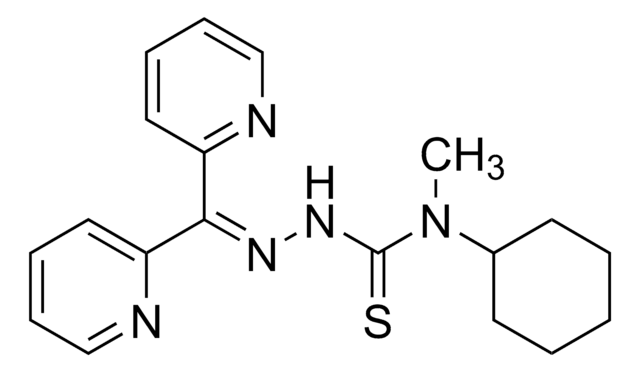SML0186
Dp44mT
≥98% (HPLC)
Sinónimos:
2-(Di-2-pyridinylmethylene)-N,N-dimethyl-hydrazinecarbothioamide, Di-2-pyridylketone-4,4,-dimethyl-3-thiosemicarbazone
About This Item
Productos recomendados
Quality Level
assay
≥98% (HPLC)
form
powder
color
yellow to orange
solubility
DMSO: ≥5 mg/mL
originator
Bayer
storage temp.
2-8°C
SMILES string
CN(C)C(=S)N\N=C(\c1ccccn1)c2ccccn2
InChI
1S/C14H15N5S/c1-19(2)14(20)18-17-13(11-7-3-5-9-15-11)12-8-4-6-10-16-12/h3-10H,1-2H3,(H,18,20)
InChI key
XOBIGRNRXCAMJQ-UHFFFAOYSA-N
Application
Biochem/physiol Actions
Features and Benefits
Caution
signalword
Danger
hcodes
Hazard Classifications
Acute Tox. 3 Oral
Storage Class
6.1C - Combustible acute toxic Cat.3 / toxic compounds or compounds which causing chronic effects
wgk_germany
WGK 3
flash_point_f
Not applicable
flash_point_c
Not applicable
Certificados de análisis (COA)
Busque Certificados de análisis (COA) introduciendo el número de lote del producto. Los números de lote se encuentran en la etiqueta del producto después de las palabras «Lot» o «Batch»
¿Ya tiene este producto?
Encuentre la documentación para los productos que ha comprado recientemente en la Biblioteca de documentos.
Artículos
Apoptosis regulation involves multiple pathways and molecules for cellular homeostasis.
Cell cycle phases (G1, S, G2, M) regulate cell growth, DNA replication, and division in proliferating cells.
Nuestro equipo de científicos tiene experiencia en todas las áreas de investigación: Ciencias de la vida, Ciencia de los materiales, Síntesis química, Cromatografía, Analítica y muchas otras.
Póngase en contacto con el Servicio técnico









